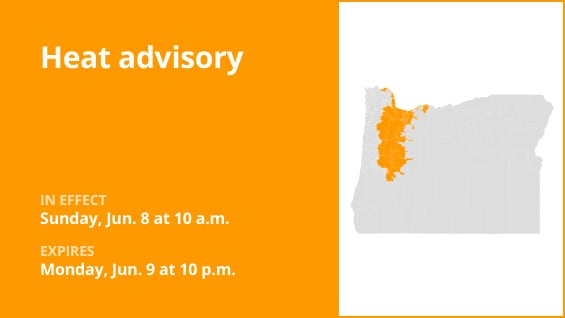On Sunday at 2:45 a.m. an updated heat advisory was released by the National Weather Service valid from 10 a.m. until Monday 10 p.m. for Lower Columbia River, Tualatin Valley, West Hills and Chehalem Mountains, Inner Portland Metro, East Portland Metro, Outer Southeast Portland Metro, West Central Willamette Valley, East Central Willamette Valley, Benton County Lowlands, Linn County Lowlands, Lane County Lowlands, West Columbia River Gorge of Oregon above 500 ft, West Columbia River Gorge I-84 Corridor, Upper Hood River Valley, Central Columbia River Gorge I-84 Corridor, Clackamas County Cascade Foothills, Cascade Foothills of Marion and Linn counties and Lane County Cascade Foothills.
“High temperatures between 92 and 98 degrees and low temperatures between 58 and 66 degrees will produce widespread Moderate HeatRisk today and Monday. Major HeatRisk will be most widespread in the Portland/Vancouver Metro, Columbia River Gorge, and Hood River Valley where temperatures will be the hottest,” can be anticipated according to the weather service. “Moderate HeatRisk is the level of heat that affects most individuals sensitive to heat, especially those without effective cooling and/or adequate hydration. Impacts are possible in some health systems and in heat-sensitive industries. Major HeatRisk is the level of heat that affects anyone without effective cooling and/or adequate hydration. Impacts are likely in some health systems, heat-sensitive industries, and infrastructure.”
“Exposure to hot temperatures may cause heat illnesses,” describes the weather service.
Heat wave safety tips: Stay safe with these recommendations from the weather service
-
Stay hydrated:
Keep yourself well-hydrated by drinking plenty of fluids. -
Seek shelter:
Opt for an air-conditioned room to stay comfortable. -
Avoid sun exposure:
Stay out of the sun, and make sure to check up on relatives and neighbors. -
Child and pet safety:
Take every precaution to never leave young children and pets alone in vehicles, especially in extreme heat when car interiors can quickly become hazardous. -
Caution outdoors:
When working or spending time outside, take extra precautions. -
Optimal timing:
If possible, move strenuous activities to early morning or evening for more favorable conditions. -
Recognize heat-related issues:
Educate yourself about the signs and symptoms of heat exhaustion and heat stroke. -
Dress for comfort:
Wear lightweight, loose-fitting clothing to stay comfortable.
Additional recommendations for outdoor workers:
- The Occupational Safety and Health Administration (OSHA) recommends frequent rest breaks in shaded or air-conditioned areas for outdoor workers.
- If someone is overwhelmed by the heat, swiftly relocate them to a cool, shaded location.
- In emergency situations, dial 911 for immediate assistance.
These NWS heat safety recommendations are vital for your well-being during periods of high temperatures. Stay informed and take the necessary steps to protect yourself and others from the heat’s potentially dangerous effects.
Advance Local Weather Alerts is a service provided by United Robots, which uses machine learning to compile the latest data from the National Weather Service.
Heat wave safety tips: Stay safe with these recommendations from the weather service
-
Stay hydrated:
Keep yourself well-hydrated by drinking plenty of fluids.
-
Seek shelter:
Opt for an air-conditioned room to stay comfortable.
-
Avoid sun exposure:
Stay out of the sun, and make sure to check up on relatives and neighbors.
-
Child and pet safety:
Take every precaution to never leave young children and pets alone in vehicles, especially in extreme heat when car interiors can quickly become hazardous.
-
Caution outdoors:
When working or spending time outside, take extra precautions.
-
Optimal timing:
If possible, move strenuous activities to early morning or evening for more favorable conditions.
-
Recognize heat-related issues:
Educate yourself about the signs and symptoms of heat exhaustion and heat stroke.
-
Dress for comfort:
Wear lightweight, loose-fitting clothing to stay comfortable.
Additional recommendations for outdoor workers:
-
The Occupational Safety and Health Administration (OSHA) recommends frequent rest breaks in shaded or air-conditioned areas for outdoor workers.
-
If someone is overwhelmed by the heat, swiftly relocate them to a cool, shaded location.
-
In emergency situations, dial 911 for immediate assistance.
These NWS heat safety recommendations are vital for your well-being during periods of high temperatures. Stay informed and take the necessary steps to protect yourself and others from the heat’s potentially dangerous effects.
Advance Local Weather Alerts is a service provided by United Robots, which uses machine learning to compile the latest data from the National Weather Service.





More Stories
Update: Heat advisory affecting Oregon until Monday night
Update: Heat advisory affecting Oregon until Monday night
Update: Heat advisory affecting Oregon until Monday night